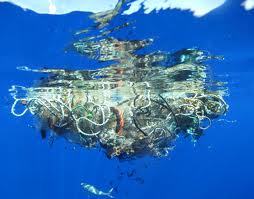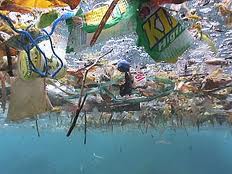One of the most exciting (or depressing, I’m not sure which) aspects of my environmental journey is learning things I had no idea about. Sometimes I know a little (enough to be dangerous?), sometimes nothing at all. The topic of today’s blog falls into that “nothing at all” category.
Have you ever heard of the Great Pacific Garbage Patch (GPGP)? Well, neither had I until recently. Being a lifelong Midwesterner my initial reaction was “Nothing to do with me.” Turns out, it has a LOT to do with me, with all of us. We helped cause it, and we can help cure it.

So what is this exactly? Actually it’s two areas in the Pacific – one between California and Hawaii (Eastern) and one between Hawaii and Japan (Western) – that together make up the largest landfill in the world. Except, of course, it’s not on land. These areas were formed by gyres, a slowly moving, clockwise spiral of currents created by air currents. The area is an oceanic desert, filled with tiny phytoplankton but few big fish or mammals. Due to its lack of large fish and gentle breezes, fishermen and sailors rarely travel through the gyre. But the area is filled with something besides plankton: trash, millions of pounds of it, most of it plastic.
The scope is hard to imagine. Scientists estimate the size of the Eastern Garbage Patch alone at two times bigger than Texas. That’s a lot of plastic! Of the more than 200 billion pounds of plastic the world produces each year, about 10 percent ends up in the ocean. Seventy percent of that eventually sinks, damaging life on the ocean floor. The rest floats; much of it ends up in gyres and the massive garbage patches that form there,
with some plastic eventually washing up on a distant shore.

Of course you can imagine what that does to ocean life. We've all seen photos of dolphins and sea turtles bound by plastic netting or birds with plastic rings around their beaks. Then there’s the jellyfish that swallow plastic bags whole and the birds that turn up dead with bellies full of plastic. Plastic never completely biodegrades. Mother Nature is gagging on it.
So when you leave an empty water bottle in the grass or the beach, let a plastic grocery sack fly down the driveway or even flick one of those little plastic stickers from an apple onto the ground, you are contributing to the GPGP. There is really no effective way to clean it up. The best we can hope for at this point is to drastically slow down what’s feeding it, which is our insatiable appetite for disposable plastics.

Here are three suggestions of how we all can help shrink the size of the GPGP:
- Don’t use plastic disposable water bottles. Instead, go with a reusable or (gasp!) glass of tap water,
- Stop using disposable plastic bags. Again, go with reusable, like those from www.naturebag.org,
- Travel only on cruise lines with ocean-friendly policies. Cruise, cargo and fishing hips are major contributors to the garbage patch.
by Peggy Huppert, Earnest Earth Mother
Peggy Huppert is the mother of three adult children, one step-son and three granddogs. She is a senior leader for a national health nonprofit and lives in the Twin Cities, USA area.
Nature Bag™ - Earth's Greenest Bag™ Reusable Bags

Leave a comment